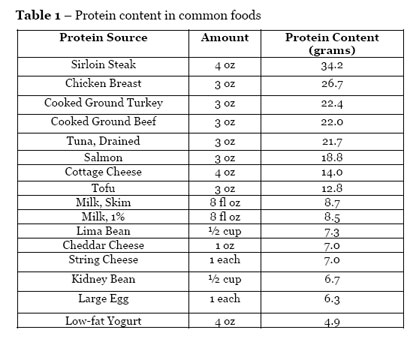Protein provides amino acids, the building blocks of all structures and organs. Besides providing the materials needed for building muscle, protein is required for the formation of hormones, enzymes and antibodies. There are 20 amino acids which are classified as essential and non-essential. If a food supplies all of the essential amino acids in appropriate ratios, it is a complete protein. Sources of complete protein include meat, fish, poultry, dairy and soy products. If a food source is low or lacking in one or more essential amino acids, it is an incomplete protein. Grains, vegetables, nuts, seeds and beans are incomplete protein sources. Combining different incomplete proteins, (i.e. beans and rice) provides a complete spectrum of the essential amino acids.
The Recommended Dietary Allowance (RDA) for protein is 0.8 grams per kilogram of body weight per day or 0.4 grams per pound per day.[1] However, protein requirements for active exercisers range from 0.5 to 0.8 grams per pound per day.[2,3] In general, your daily needs for protein (in grams) equate to approximately half your weight in pounds. For example, if you weigh 150 pounds, you need approximately 75 grams of protein every day. The recommended range for protein is 10 to 35 percent of daily calories. Lean protein sources such as chicken, fish, low- and non-fat dairy, soy products and beans are good protein sources and are a part of an overall healthy diet. Common foods and their protein content are listed in the table below.

References
1 Institute of Medicine. Dietary Reference Intakes for Energy, Carbohydrate, Fiber,Fat, Fatty Acids, Cholesterol, Protein, and Amino Acids. Washington, DC: National Academies Press, 2005.
2 American College of Sports Medicine, American Dietetic Association, and Dietitians of Canada. Joint position statement: nutrition and athletic performance. Med. Sci. Sports Exerc. 32:2130-2145, 2000.
3 Phillips SM. Protein requirements and supplementation in strength sports. Nutrition. 2004 Jul-Aug;20(7-8):689-95. Review.